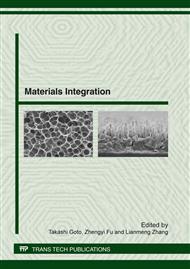[1]
A. Badzian, Stability of silicon carbonitride phases, J. Am. Ceram. Soc. 85 (2002) 16-20.
Google Scholar
[2]
N.I. Fainer, Y.M. Rumyantsev, M.L. Kosinova, Functional Nanocrystalline Films of Silicon Carbonitride, Chemistry for Sustainable Development. 9 (2001) 31-36.
Google Scholar
[3]
C.W. Chen, C.C. Huang, Y.Y. Lin et al., Optical properties and photoconductivity of amorphous silicon carbon nitride thin film and its application for UV detection, Diamond and Relat. Mater. 14 (2005) 1010-1013.
DOI: 10.1016/j.diamond.2004.11.027
Google Scholar
[4]
M.L.P. da Silva, I.H. Tan, F.A.P. Nascimento at al., Use of plasma polymerized highly hydrophobic hexamethyldisilazane (HMDS) films for sensor development, Sensor Actuat. B.: Chem. 91 (2003) 362-369.
DOI: 10.1016/s0925-4005(03)00112-6
Google Scholar
[5]
A.T. de Carvalho, R.A.M. Carvalho, M.L.P. da Silva et al., Hydrophobic Plasma Polymerized Hexamethyldisilazane Thin Films: Characterization and Uses, Materials Research. 9 (2006) 9-13.
DOI: 10.1590/s1516-14392006000100003
Google Scholar
[6]
N. Fainer, Y. Rumyantsev, M. Kosinova et al., Low-k dielectrics on base of silicon carbon nitride films, Surf. Coat. Technol. 201 (2007) 9269–9274.
DOI: 10.1016/j.surfcoat.2007.04.046
Google Scholar
[7]
N.I. Fainer, M.L. Kosinova, Yu.M. Rumyantsev et al. Thin silicon carbonitride films are perspective low-k materials, J. Phys. Chem. Sol. 69 (2008) 661-668.
DOI: 10.1016/j.jpcs.2007.07.061
Google Scholar
[8]
D. Schneider, T. Schwarz, A photoacoustic method for characterizing thin films, Surf. Coat. Technol. 91 (1997) 136-146.
Google Scholar
[9]
J. -H. Zhao, T. Ryan, P.S. Ho., Measurement of elastic modulus, Poisson ratio, and coefficient of thermal expansion of on-wafer submicron films, J. Appl. Phys. 85 (1999) 6421-6424.
DOI: 10.1063/1.370146
Google Scholar
[10]
J. Tauc R. Grigorovichi, A. Vancu, Optical properties and dielectric structure of amorphous germanium, Physica Status Solidi. 15 (1966) 627-637.
DOI: 10.1002/pssb.19660150224
Google Scholar
[11]
N.I. Fainer, Y.M. Rumyantsev, M.L. Kosinova, Physical and Chemical Transformations in Thin Films of Silicon Carbonitride during Thermal Annealing, Chemistry for Sustainable Development. 9 (2001) 37–43.
Google Scholar


